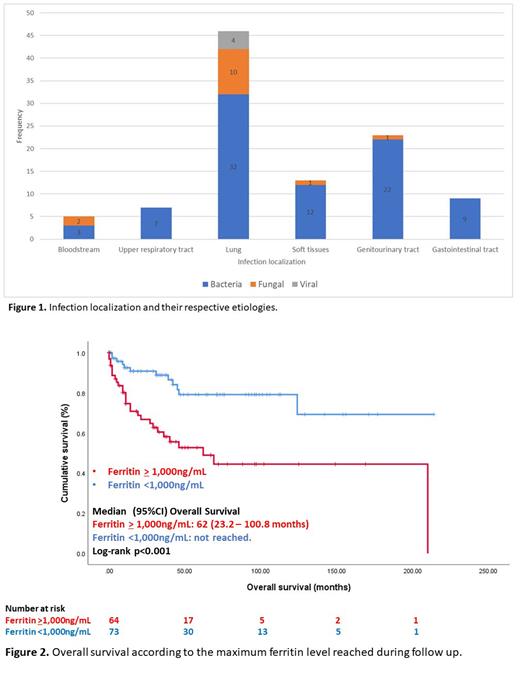INTRODUCTION.
Mortality differs according to the Revised International Prognostic Scoring System (IPSS-R) risk categories in patients afflicted with myelodysplastic syndromes (MDS). Historically, high-risk (HR)-MDS (IPSS-R >3.5 points) is related to death caused by progression to acute myeloid leukemia (AML), while low-risk (LR)-MDS is associated with mortality due to severe infections (Nachtkamp K, et al. 2016), probably caused by neutrophile dysfunction and hindered oxidative burst.
Studies of causes of death (COD) in MDS are scarce. A MD Anderson study in LR-MDS patients identified infections as the leading COD, followed by progression (Dayyani F, et al, 2010), while the Düsseldorf registry recognized infections as the main COD across all MDS categories (Neukirchen, J. et al, 2011).
Considering that information in low- and medium-income countries is especially limited, this study aims to describe the characteristics and identify the risk factors for severe infectious events in patients afflicted by MDS in a third-level center in Mexico.
METHODS.
In this single-center retrospective study, we analyzed severe infection episodes, associated risk factors, and the COD in MDS patients.We included patients diagnosed with MDS from January 2000 to December 2021, according to the 2016 WHO criteria. We registered baseline characteristics and described the episodes of severe infection, defined as hospitalization events due to infectious diseases complicated with septic shock and/or respiratory failure requiring orotracheal intubation. We conducted uni- and multivariate analyses based on the following variables: neutropenia (≤0.5x10 9/L), monocytopenia (≤0.2x10 9/L), lymphopenia (≤1.0x10 9/L), ferritin (≥1,000ng/mL), autoimmune disease, MDS comorbidity index, COPD, granulocyte dysplasia, and treatment with azacytidine or pharmacological immunosuppression.
RESULTS.
We included 156 patients with MDS treated at our institution. Median age at diagnosis was 65 years (IQR; 55-75 years), 53% of which were women. Multilineage dysplasia was the most prevalent MDS type (59%), followed by excess blasts type 2 (11.5%). LR-MDS represented 68% (n=106), while HR-MDS, 32% (n=50). Hypocellularity in bone marrow biopsy was found in 24.4%.
Eighty-seven patients developed 156 infectious episodes, 64.7% of which were severe. A median of 1 serious event (IQR: 0.75-1 event) occurred in each patient, with a median time to diagnosis of 13 months (IQR: 3.5-34.5 months). Infection sites and etiologies are described in Figure 1. Of note, we identified 14 fungal infections, 8 of them by Aspergillus, with a 37.5% death rate.
Risk factors associated with increased severe infection risk were neutropenia during follow-up (OR 3.2; 95% CI 1.5-6.4; p=0.001), neutrophil hypogranularity at diagnosis (OR 2.1; CI 95% 1.1-4.1; p=0.029), hyperferritinemia (OR 2.46; CI 95% 1.2-4.9; p=0.011), and azacitidine treatment (OR 3.1; CI 95% 1.01-9.6; p=0.047).
Fifty patients (32%) died. In both HR-MDS and LR-MDS groups, the main COD was infection (13 in HR group, 48.1%, vs 10 in LR group, 43.5%; p=0.782), followed by progression to AML (3 in HR group, 11.1%, vs 4 in LR group, 21.7%; p=0.444). Median overall survival was lower in patients with severe neutropenia (62 vs. 210 months; p=0.009) and hyperferritinemia (62 months vs. non-reached, p<0.001) (Figure 2).
CONCLUSIONS
In our MDS population severe infections represent the leading COD, regardless of risk category. More than half developed at least one infectious episode, 64.7% of which were severe. Fungal infections were highly lethal, suggesting antifungal prophylactic interventions could prove helpful. We found neutropenia during follow-up and hypogranularity at diagnosis to be significant risk factors, the latter perhaps reflecting neutrophil disfunction which should be further evaluated. Hyperferritinemia's association with increased infection and mortality urges to further understand its role in MDS pathophysiology, and could potentially prove a therapeutic target in infections disease prevention. Additionally, there is currently no consensus on infectious disease for use of azacitidine, which might add to a worsening risk of infection.
Disclosures
Demichelis:Abbvie: Honoraria; AMGEN: Consultancy, Honoraria; Astellas: Consultancy, Honoraria; TEVA: Consultancy, Honoraria; Pfizer: Consultancy, Honoraria. Apodaca Chavez:Astra Zeneca: Speakers Bureau.


This feature is available to Subscribers Only
Sign In or Create an Account Close Modal